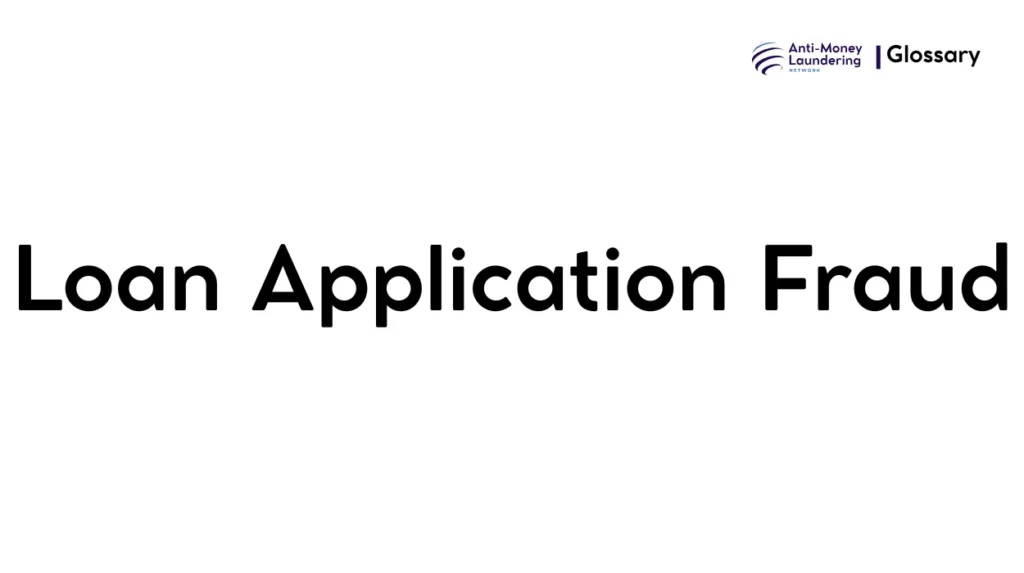Definition
Loan Application Fraud in the context of AML refers to the deliberate falsification or manipulation of information on loan applications with the intent to conceal illicit origins of funds or to exploit financial institutions and regulatory gaps. It is a method through which criminals attempt to integrate illicit proceeds into the financial system under the guise of legitimate borrowing.
Purpose and Regulatory Basis
Loan Application Fraud plays a critical role in AML frameworks as it represents a common vector for money laundering activities. Disguising illegal funds as loan proceeds or repayments, fraudsters exploit loan processes to cleanse money. Regulatory bodies such as the Financial Action Task Force (FATF) emphasize scrutinizing loan applications to identify suspicious patterns. National laws, including the USA PATRIOT Act and the European Union’s Anti-Money Laundering Directives (AMLD), mandate financial institutions to implement stringent customer due diligence (CDD) and transaction monitoring specific to lending activities.
When and How it Applies
Loan Application Fraud typically surfaces during the loan application, approval, and disbursement phases. Indicators include overstated income, forged documents (e.g., pay slips, tax returns), identity theft, or the use of complex ownership structures to disguise beneficiaries. Real-world cases involve applicants inflating financial standing to access larger loans that are ultimately used to funnel and legitimize illicit funds. Institutions are triggered to apply enhanced scrutiny when discrepancies, unusual business profiles, or unrelated third parties are involved in loan applications.
Types or Variants
Several forms of Loan Application Fraud relevant to AML include:
- Income or Asset Inflation: Overreporting earnings or assets to secure credit.
- Synthetic Identity Fraud: Creating fictitious identities or combining real and fake information.
- Straw Borrowing: Using third parties to apply for loans on behalf of criminals.
- Loan Stacking: Applying for multiple loans simultaneously to exhaust credit.
- Document Forgery: Submission of falsified verification documents.
Each aims to obscure the actual source or destination of funds, facilitating money laundering.
Procedures and Implementation
Financial institutions must deploy robust loan application screening protocols to comply with AML obligations. Key steps include:
- Customer Due Diligence (CDD): Verifying identity and assessing risk profile.
- Enhanced Due Diligence (EDD): Applying for high-risk applicants or complex ownerships.
- Verification of Documents: Cross-checking income, employment, and financial documents.
- Transaction Monitoring: Observing loan disbursements and repayments for unusual activity.
- Staff Training: Ensuring frontline and compliance teams recognize AML red flags.
Institutions often use automated systems with AI and machine learning to detect anomalies and generate alerts.
Impact on Customers/Clients
Customers may face additional identity verification steps, longer processing times, and more thorough background checks to prevent fraud. While these measures protect the financial system, they can sometimes be perceived as intrusive. Clients have the right to understand data protection measures and appeal decisions. Transparent communication is essential to maintaining trust and compliance.
Duration, Review, and Resolution
AML compliance related to loan applications is ongoing. Initial screening happens at application, but monitoring continues throughout the loan lifecycle, including repayment and closure. Institutions conduct periodic reviews of high-risk loans and update risk assessments. Suspicious findings may require escalation, including suspending disbursements or initiating investigations, until resolution.
Reporting and Compliance Duties
Financial institutions must maintain comprehensive records and report suspicious activities to the relevant Financial Intelligence Unit (FIU). Failure to comply can lead to penalties under laws like the USA PATRIOT Act, EU AMLD, and other national frameworks. Regular audits and regulatory examinations assess adherence to AML requirements involving loan products.
Related AML Terms
Loan Application Fraud intersects with:
- Customer Due Diligence (CDD)
- Suspicious Activity Reporting (SAR)
- Know Your Customer (KYC)
- Politically Exposed Persons (PEP) screening
- Transaction Monitoring Systems (TMS)
These terms collectively contribute to detecting and preventing money laundering in lending.
Challenges and Best Practices
Challenges include sophisticated fraudulent schemes, identity theft, and evolving regulatory requirements. Best practices involve integrating AI-driven analytics, continuous staff training, collaboration with law enforcement, and staying updated on typologies. Institutions should establish clear escalation protocols and maintain open channels with regulators.
Recent Developments
Emerging technologies like artificial intelligence and blockchain analytics enhance fraud detection. Regulatory bodies are expanding mandates to cover non-traditional lenders and fintech platforms, reflecting the evolving loan landscape. Increased international cooperation improves information sharing to combat cross-border loan fraud.
Loan Application Fraud in AML is a crucial risk area where criminals attempt to launder money by manipulating loan processes. Strong regulatory frameworks, combined with advanced detection systems and institutional vigilance, are essential to protecting financial integrity. Understanding and addressing this fraud type is vital for effective AML compliance and risk mitigation.

